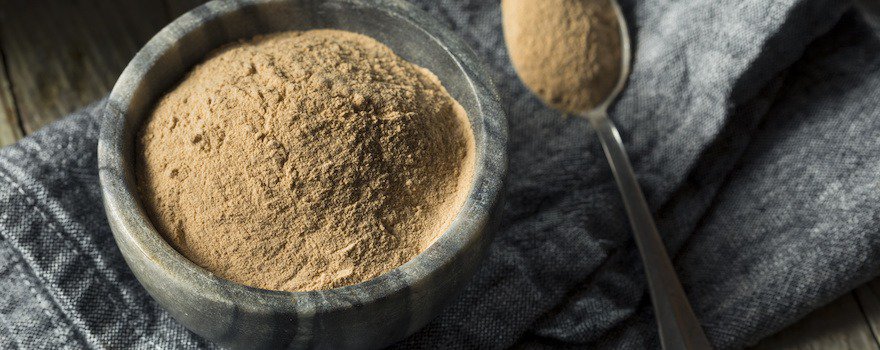BENEFITS OF LUCUMA
✓ High in fiber and can replace sugar
✓ Source of antioxidants
✓ Helps regulate blood sugar
✓ Protects the heart
What is lucuma?
Lucuma is a fruit from Pouteria lucuma, a tree in the Sapotaceae family. It grows in the Andean valleys, in Peru and Ecuador, and can reach up to 15 meters in height. Its fruit is the main ingredient of delicious desserts, pastries, and ice creams in South America. There it is nicknamed “the gold of the Incas”.
Lucuma leaves are dark green and cluster at the ends of the branches, while the yellow and green flowers produce the fruit, which takes about 9 months to reach maturity after the flower is pollinated. The fruit is oblong with a conical tip. Its flesh has a beautiful yellow-orange color, a dry texture, and a very sweet taste reminiscent of caramel, sweet potato, or maple syrup.

Originally, lucuma grows at high altitudes, between 2700 and 3000 meters. Although it was initially found only in the Andes, the fruit is now mostly cultivated in coastal regions, at around 500 meters, from October to March. In addition to Peru and Ecuador, it is also found in Bolivia, Chile, and, to a lesser extent, Costa Rica.
Peruvians have been consuming it since ancient times. Lucuma was, moreover, part of the iconography of the Mochica people between 100 and 700 AD: many objects representing this fruit have been found in funerary sites. Europeans discovered it during the conquest, and its existence is first mentioned in Ecuador in 1531. The word lucuma comes from the Quechua lluku uma, meaning “ancestor’s head”.
As noted, lucuma has a dry texture when eaten raw. It is usually used to add flavor in cooking: to flavor a juice, a cake, or a mousse. But it is above all lucuma ice cream that enjoys enormous popularity in Peru and elsewhere in Latin America.
As you may have guessed, this fruit is delicious! But it is also particularly healthy and nutritious. Lucuma is very high in fiber, potassium, vitamin B3, antioxidants such as beta-carotene, and is an excellent substitute for sugar.
It is therefore an ally from a nutritional point of view, especially if you are looking to reduce or replace sugar in your diet, to improve your health, lose weight, or prevent certain diseases. In Europe, lucuma is mainly found in powdered form or as a food-grade flour, because its thin, fragile skin does not tolerate export.
Nutritional composition
- Fibres
- Protéines
- Vitamines : A, B1, B2, B3, C
- Minéraux et oligo-éléments : calcium, fer, phosphore, potassium, sodium

The benefits of lucuma
🍦 Rich in fiber and replaces sugar
Lucuma’s nutritional value is very high; it has a low glycemic index, and its delicate, sweet taste makes it possible to replace or limit refined sugar in our diet.
It is notably rich in soluble and insoluble fiber, facilitating digestion and bowel transit. On the one hand, lucuma’s insoluble fibers help increase stool bulk and prevent constipation. On the other hand, the soluble fibers it contains nourish the microbiota (formerly known as the intestinal flora), acting as prebiotics.
They also help our bodies absorb minerals. And, in fact, lucuma also contains them: mainly calcium, but also iron, phosphorus, potassium, and sodium.
Dietary fiber contributes to the good health of our digestive system, but that’s not all. Its benefits for digestion help improve our overall health, support proper brain function, and help prevent certain diseases.
In addition to this nutritional benefit, lucuma can advantageously replace sugar in our diet. It is an appealing alternative to refined sugar, especially since only a small amount of lucuma powder can easily sweeten a dessert or a drink.
🥝 Source of antioxidants
Lucuma is an excellent source of antioxidants. These protect us by fighting the damage caused by free radicals, molecules that harm our cells and accelerate aging. They also help protect us against heart disorders and can help prevent the onset of cancer.
Our fruit is rich in polyphenols and carotenoids, antioxidants that are especially active against inflammation. They give it its beautiful yellow-orange color and notably help protect our eyes. Among its notable antioxidants is vitamin C.
This in-vitro study, conducted by several Chilean universities, demonstrates the antioxidant activity of lucuma.
🍭 Helps regulate blood sugar
Lucuma, or at least its components, may regulate and lower blood glucose (blood sugar levels) and protect against type 2 diabetes.
It contains simple sugars, but especially complex carbohydrates: starch and fiber. These help regulate blood sugar levels and protect against diabetes by improving insulin sensitivity and preventing post-meal blood sugar spikes.
Lucuma’s mechanisms would be similar to those of antidiabetic drugs. It would block the action of enzymes that convert complex carbohydrates into simple sugars, the alpha-glucosidase enzymes.
Moreover, as previously noted, lucuma has a low glycemic index and easily replaces sugar in desserts, snacks, and beverages, which thereby reduces blood sugar levels. It should still be consumed in moderation.
This in vitro study conducted by various Chilean universities demonstrates lucuma’s antihyperglycemic properties.
This study, conducted by the University of Sao Paulo on several fruits native to Peru including lucuma, shows that it inhibits the alpha-glucosidase enzyme and has potential to complement antidiabetic medications.
❤️ Protects the heart
Thanks to the polyphenols it contains, lucuma may help protect the heart from cardiovascular disease. They notably contribute to lowering blood pressure.
These properties are still under study, although early results are promising.
This study conducted by the University of Sao Paulo on several fruits native to Peru including lucuma shows its antihypertensive potential.

How to consume lucuma?
Lucuma powder
Unless you go to a Peruvian or Chilean grocery store, which may offer frozen lucuma pulp, it will be difficult to find it outside South America. However, lucuma powder is sold in health food stores and online retailers.
It is obtained by drying the flesh at low temperature to preserve all its health benefits, then grinding the fruit until a fine powder is obtained. This powder is ocher and resembles the fruit’s original color.
As always, organic lucuma that is fair-trade certified should be preferred.

You can also find mixes of several superfoods containing lucuma in health food stores; it is often mixed with maca or moringa, both for its properties and to mellow the taste of the blend.
Lucuma powder pairs very well with other fruits. You can sprinkle it over a fruit salad (it works particularly well with banana, apples, mangoes, for example), a muesli, a yogurt, or blend it into a smoothie…
You can also dilute it in water, but it would be a shame to miss out on its sweetening power!
Lucuma as a sugar substitute

We consume an average of 35 kg of refined sugar per year! Not only does it offer us little nutritionally, but it is also addictive, contributes to many health problems, and promotes obesity.
Lucuma powder is a good alternative, just like honey or agave syrup. You can easily make desserts and snacks with it instead of ordinary sugar. Its taste when cooked will be similar to that of brown sugar.
It is recommended to replace half of the sugar in a cake, pastry, or other recipe with lucuma powder. It also makes a good thickener.
Dosage
⏳You can add lucuma to your diet year-round as a substitute for sugar. There is no “cure” per se.
⚖️ Recommended doses range from 5 to 15 g per day. Be sure to consume it in moderation!
Contraindications and side effects
At recommended doses, there are no contraindications or side effects. If you have allergies to exotic fruits, it’s best to consult a doctor before consuming lucuma.
History, cultivation, and market
From the Andes to Hawaii
Native to the Andean valleys, archaeological evidence of lucuma cultivation and use has been found among pre-Inca peoples on the Pacific coast, such as the Nazca and the Mochica. They widely depicted it in their everyday objects and used its wood for architectural purposes.
The oldest evidence of its consumption was found in Ancash, in northern Peru, along the Pacific. They date from 6000 BC. Since then, lucuma has been part of the daily diet of pre-Columbian peoples, alongside maize and quinoa.
When the Spanish conquistadors arrived, it was also cultivated in southern Ecuador. It was later introduced to Bolivia, Chile, and, since the early 20th century, to Costa Rica. Today, it’s even found in Mexico and Hawaii! In addition, cultivation trials took place in Florida, but the tree could not properly adapt to the climate.
A fruit native to the mountains that grows better on the coast
The lucuma tree grows ideally between 20 and 22°C in a temperate climate. It requires nutrient-rich soil with a neutral pH, although it can tolerate more alkaline soils. While resistant to episodes of drought or humidity, it cannot, however, develop well at high temperatures or during heavy rains, and it does not withstand frost.
Although it is native to the Andes and originally grew at high altitudes, lucuma now finds its optimal growing conditions at 500 meters above sea level. In this context, the tree produces between 200 and 300 fruits four years after planting.
A national dessert and an expanding market
Lucuma is the national dessert of Peru. Its inhabitants consume it primarily as ice cream and in pastries, such as the suspiro limeño con lucuma, a particularly tasty fruit cream and meringue. The famous chef Gaston Acurio contributed to its global fame by creating the brownie de chocolate con mousse de lucuma.
The lucuma market is booming. In Peru, its exports have increased by 16% since 2015. Chile is the leading exporter of the fresh fruit and its frozen pulp. The United States is the top destination for lucuma powder, followed by Europe.
Sources and scientific studies
Fuentealba C, Gálvez L, Cobos A, Olaeta JA, Defilippi BG, Chirinos R, Campos D, Pedreschi R, 2016. Characterization of main primary and secondary metabolites and in vitro antioxidant and antihyperglycemic properties in the mesocarp of three biotypes of Pouteria lucuma.
Pinto Mda S, Ranilla LG, Apostolidis E, Lajolo FM, Genovese MI, Shetty K, 2009. Evaluation of antihyperglycemia and antihypertension potential of native Peruvian fruits using in vitro models.



